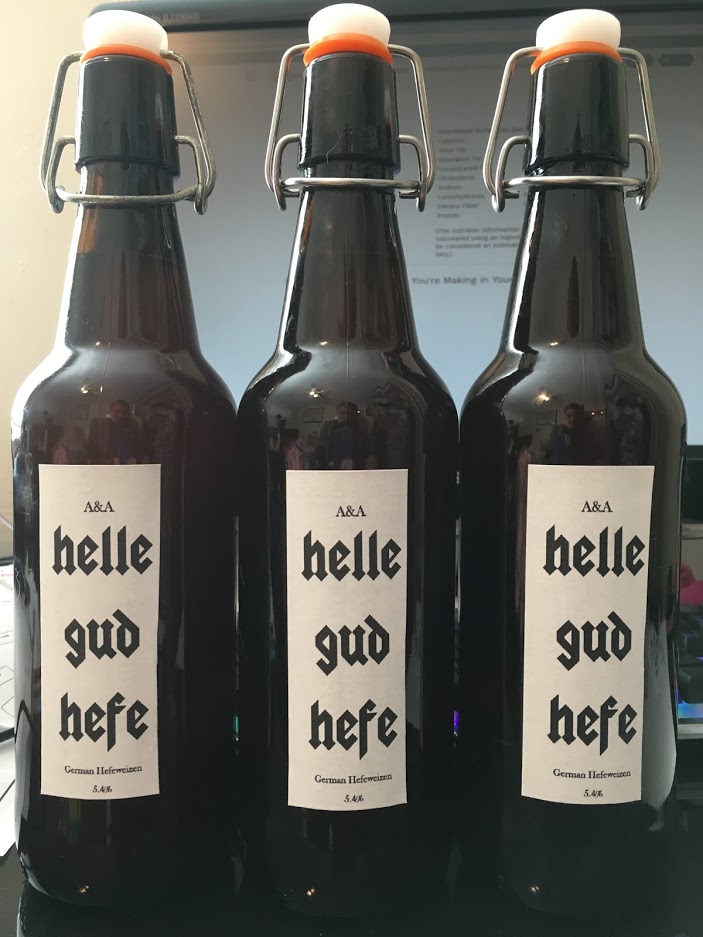
Summer is nearly upon us, even though the pandemic has trapped most of us indoors, and keeps the rest away from congregating in our favorite bars and breweries. Over the past few years, we’ve been inspired to home brew by a couple local beers to make easy drinking, flavorful beers.
What makes a beer easy to drink? Depends on the person, but for us easy drinking beers are light and crisp. Lager style beers are popular, but harder to make for the first timer trying to home brew. Ales are easier to make, so we tried our hand at a couple of styles: a Hefeweizen, a Lemon Ale (NOT a Shandy!), and a Basic Blonde.
Basic Ingredients in a Hefe
We called our home brew version a “Helle Guud Hefe” for fun, but we used a basic recipe from MoreBeer.com. The first Hefe we brewed came from a kit we got as a Christmas gift. The kit included:
- Six pounds of Bavarian Wheat Dry Malt Extract (DME)
- 1 oz pouch of Northern Brewer Hops (recipe only uses 0.5 oz)
- One recipe
That was it.
We still needed to pick our own yeast, so we used the yeast recommended by the recipe, which was a White Labs WLP Hefeweizen.
Using the DME made brewing this recipe super easy. We way overestimated our ability to brew beer by going all-grain with our first batch, which resulted in boil over, a burst grain bag, straining the mash with a colander, and ultimately throwing out a spoiled batch of beer that had cost us over $50 in ingredients.
You boil the water, put the hops in a small hop bag, mix the DME into the boiling water, hang the hops into the water, and boil for 60 mins. Then, let the mix, called the wort, cool down until it’s about room temperature. Read your yeast instructions (and realize that you should have read them before you started brewing)…
Ok, so hopefully you’ve read this far before trying to home brew your first beer. Your first step with brewing is actually prepping your yeast. Some yeast strains need to be started before you can pitch them into your beer. Some manufacturers may say that you need two pouches for your batch, unless you start it early to increase the yeast count. Read those instructions carefully and do that BEFORE boiling.
Back to the wort. It’s a good idea to just take a sip of that before you add the yeast. If you don’t like the taste of the sugary wort before your make the beer, there’s a chance that you might not like it after it’s fermented and carbonated, and you wasted a month waiting around for the wort to ferment.
Take you hydrometer reading and make sure you don’t need to boil for longer, add more DME, or add more (boiled) water back in. Transfer your wort from your boiling kettle to your fermenter, pitch your yeast, and pop in the airlock.
Check your hydrometer readings periodically until you get to the final gravity reading. At that time, you can bottle your beer, add priming sugar, and wait until you can throw it in the fridge. If you start now (post was written in early may), the beer will be ready before the first day of summer.
Our Basic Blonde
We actually made this beer after the Lazy Lemon I’ll discuss next, but when you get there you’ll see why.
Relying on our copy of Brewing Classic Styles, we made this home brew beer to suit our preference for low IBUs (International Bitterness Units), which to us is a prerequisite in easy-drinking, summer beers.
This recipe required:
- 8.3 lbs of Light LME – which converts to about 6.95 lbs of DME. (side note, when I went to the Homebrewer for supplies, the shopkeep had to point out that I needed to convert between LIQUID malt extract to DRY malt extract).
- 0.5 lb of Crystal grains
- 0.98 oz of Willamette hops
- Whitelabs WLP001 California Ale
This blonde ale is totally a west coast brainchild. It’s light, crisp, and refreshing, everything that we wanted. All the recipes in the book are super easy to follow.
Lazy Lemon Ale
Bolt Brewery nearby has an amazing lemon blonde ale in the summer. I swear we drank gallons of this the first summer we lived in San Diego. The IBUs are super low, around 7. We wanted to recreate this beer to have on hand, cause face it, buying growlers every weekend can get a little pricey.
We still struggle sometimes to find recipes online that make sense to us, so The blonde ale recipe is a bit higher than our comparison beer but decided to go with it anyways.
After boiling and pitching and all that, we tried to figure out how to get the lemon flavor into the beer. We ended up peeling a couple of ripe lemons from our yard, making sure they were sanitary, and threw the peels into the wort before popping the airlock in.
And what do you know? It worked.
Now, the beer wasn’t as sweet, and was definitely more bitter, than the Bolt Brewery Loca Lemon, but it was pretty dang good. We struggled a bit with the carbonation later on, but that didn’t stop us from knocking back all 40 bottles over the summer.
I ended up calling it the Lazy Lemon cause I wanted to call it the LLL (with the last L for lager, which isn’t not). But with the ease the recipe, you can definitely be pretty lazy and still get a great beer!
I hope these recipes help inspire you to put something on in preparation for the summer!
